| Alstom Movia R151 | |
 |
|
| In service | 2023 |
| Manufacturer | Alstom |
| Constructed | Changchun Alstom Railway Vehicles |
| Number built | 636 vehicles (106 trainsets) |
| Formation | 6 cars per trainset DT–M1–M2–M2–M1–DT |
| Fleet number | 801/802 – 897/898 & From 901/902 |
| Operators | SMRT Trains |
| Depot(s) | Tuas, Changi, Bishan |
| Line(s) served | North South Line & East West Line |
| Technical Data | |
| Doors | 8 per car |
| Traction | Alstom MITrac SiC–VVVF |
| Electrification | 750 V DC Third rail |
| Signalling | Thales SelTrac CBTC |
| Track gauge | Standard Gauge (1435mm) |
The Alstom Movia R151 Train is an electric multiple unit (EMU) train procured by Singapore’s Land Transport Authority (LTA) for the North South Line and East West Line. A total of 106 trains were ordered under Contract R151 which entered passenger service on 4 June 2023.
As the seventh generation of rolling stock for the NSEWL, these R151 trains are intended to replace the three earliest generations of rolling stock that served on Singapore’s oldest metro lines, namely the C151, C651 and C751B.
An initial tender for 66 trains was awarded to Bombardier for $827.1 million on 25 July 2018, as direct replacements for C151 trains. A further 40 additional trains were announced on 28 September 2020, at a cost of $337.8 million, as direct replacements for C651 and C751B trains. The contract would be fulfilled by Alstom, who acquired Bombardier’s rail business in January 2021, with trains subsequently adopting the Alstom name (formerly Bombardier MOVIA R151, now Alstom Movia R151).
In addition to these costs, Contract R151 includes an option to provide long-term service support to the Train Operator (SMRT Corporation) for the new train fleet, covering their design life of up to 30 years. For the initial 66 trains, this contract was valued at just under $400 million (in mixed currencies); a revised figure for all 106 trains has yet to be released.
Passenger service began on Sunday, 4 June 2023, with the deployment of R151 trains on the East West Line. Passenger service on the North South Line first started on Saturday, 25 May 2024.
Background
Main Article: Kawasaki Heavy Industries C151
As the first-generation C151 trains were approaching the end of their lifespan, SMRT was exploring ways to overhaul these trains for continued service. In 2014, SMRT inked a deal with Japan’s Toshiba to replace all 66 trains with Permanent Magnet Synchronous Motors (PMSM), reducing power consumption by 30%, noise levels by 12 dB and being easier to maintain. This was part of a major engineering component replacement on all C151 trains expected to be completed by 2019.
However, in August 2016, LTA and SMRT agreed to transition all its existing rail lines to the New Rail Financing Framework (NRFF) from 1 October 2016, in which the Government assumes responsibility for the expansion, replacement and refurbishment of all operating assets, including trains. Refurbishment works were halted as LTA reviewed the best course of action, despite SMRT already being committed to the installation of the new PMSM propulsion system (see also: SMRT C151 End-of-Life upgrade / PMSM retractioning project).
In October 2016, the LTA announced its intention to replace all 66 first-generation C151 trains with brand-new ones, favouring the procurement of new trains over continuing to refurbish old trains. Contract R151 for the replacement of these trains closed on 4 September 2017, and was subsequently awarded to Bombardier in July 2018, who would supply Bombardier MOVIA trainsets under this contract.
Participating companies were:
| S/No | Tenderer | Tender Amount |
|
| Base | Alternative | ||
| 1. | Alstom Transport S.A. / Alstom Transport (S) Pte Ltd Consortium |
SGD 682,696,431.00 | — |
| 2. | Bombardier (Singapore) Pte Ltd | SGD 827,075,921.00 | — |
| 3. | Construcciones y Auxiliar de Ferrocarriles, S.A. | SGD 867,275,662.00 | — |
| 4. | Hyundai Rotem Company | SGD 696,960,000.00 | — |
| 5. | Kawasaki Heavy Industries, Ltd. CRRC Qingdao Sifang Co., Ltd. Kawasaki Heavy Industries (Singapore) Pte. Ltd. Singapore CRRC Sifang Railway Vehicles Service Pte. Ltd. Consortium |
SGD 999,900,000.00 | SGD 884,188,800.00 |
Part of the tender involves an option for Long Term Service Support to the Train Operator (SMRT Corporation). The bids for this option (Option 9) are reflected below.
Long Term Service Support (Option 9) Bids| S/No. | Tenderer | Tender Amount | ||
| Base Option 9 |
Alternative 1 Option 9 |
Alternative 2 Option 9 |
||
| 1. | Alstom Transport S.A. / Alstom Transport (S) Pte Ltd Consortium |
SGD 626,697,233.00 | — | — |
| 2. | Bombardier (Singapore) Pte Ltd | Mixed Currencies: SGD 269,652,420.94 + EUR 75,135,673.16 + GBP 2,670,699.27 |
Mixed Currencies: SGD 249,411,319.78 + EUR 69,567,878.63 + GBP 2,472,791.89 |
Mixed Currencies: SGD 246,276,896.97 + EUR 67,344,629.08 + GBP 2,393,766.43 |
| 3. | Construcciones y Auxiliar de Ferrocarriles, S.A. | SGD 307,320,742.00 Mixed Currencies: |
— | — |
| 4. | Hyundai Rotem Company | SGD 517,973,000.00 | — | — |
| 5. | Kawasaki Sifang Consortium
Kawasaki Heavy Industries, Ltd. |
SGD 1,111,653,342.00
Mixed Currencies: |
SGD 1,111,653,342.00
Mixed Currencies: |
— |
The long-term service support covers a period of 10 years, with an option to extend for a further 20 years.
R151 trains would be assembled in Bombardier’s facility in Changchun, China, and would undergo a rigorous testing and commissioning process before they are put into passenger service from 2022. The facility in China, Changchun Bombardier Railway Vehicles, is a joint venture between Bombardier and CRRC Changchun Railway Vehicles.
As for the Bombardier MOVIA family of metro trains, 92 sets of 3-car trains (Bombardier MOVIA C951) were built for the Downtown Line between 2012 and 2017.
Expanded order
In September 2020, a further 40 more Contract R151 trains were announced as part of a long-term fleet renewal programme. At a cost of $337.8 million, these new trains will replace all second-generation C651 trains (19 units) and all third-generation C751B trains (21 units). These new trains will arrive in batches starting from 2024.
Trains to be replaced by new Contract R151 trains from Bombardier:
| Retiring | Incoming |
|
|
The entire change-out of the 106 first 3 generations of trains with Alstom Movia R151 trains is expected to complete by 1Q 2026, according to the SMRT Group Review 2022/2023.
Acquisition by Alstom
Alstom completed its acquisition of Bombardier’s rail business (Bombardier Transportation) in January 2021. As such, Alstom assumed responsibility for the delivery of Contract R151, and trains were renamed to Alstom Movia, reflecting Alstom’s takeover of Bombardier’s family of metro trains. It is not known whether the change in ownership resulted in changes to the technical specifications of these trains.
R151 trains would also continue to be assembled in Changchun, China. The joint venture company was renamed Changchun Alstom Railway Vehicles; a joint venture between Alstom and CRRC Changchun Railway Vehicles.
Service entry delays
Initial press releases stated that trains would be delivered to Singapore in batches from 2021; this was delayed to February 2022 likely due to COVID-19-related disruptions. A Zaobao article on 31 October 2022 reported that the new trains would commence passenger service in 2023.
On 1 June 2023, the Land Transport Authority announced that the train would commence passenger service on Sunday, 4 June 2023. The first train was launched from Tuas MRT Depot and departed Tuas Link station at about 7.10 am.
Construction
R151 trains are constructed with aluminium alloy with 4 external sliding doors per side of each car.
Commuter Facilities
The interior cabins of the train were designed to include more open spaces for parents with strollers, wheelchair users and commuters carrying their personal mobility devices (PMDs).
Large, panoramic windows provide commuters with an improved viewing experience while travelling along above-ground stations. The new trains were also designed with ergonomic perch seats, which can accommodate more commuters on the trains. Other features included an LCD display system above every door to show the route and station information.
Initial concept drawings showed that trains would feature tip-up seats, which can be folded up during peak hours to create more room for passengers without reducing the overall number of seats per train car. Similar seats were installed on C151C trains. However, these were replaced with fixed longitudinal seats and perch seats in later concept drawings, and this feature was not implemented on the actual train.
Diagnostic Features
The trains come equipped with a modern Train Control & Management System (TCMS) which controls many train subsystems. This includes a self-test system that automatically checks that trains are fit for operation before daily service commences. According to The Straits Times [Link], the system requires approximately 12 minutes to run each morning, and has aided maintenance staff by providing precise diagnostics for specific faults in the trains’ various subsystems (i.e. conditioning, doors, brakes, propulsion and auxiliary power systems), while also automating certain routine checks which had to be manually conducted once every three weeks at minimum.
In addition, trains were designed with the input of SMRT engineers, leading to designs which were more convenient and safer to maintain. For instance, the air-conditioning filters on older trains had to be replaced from the train’s roof, which exposed workers to height-related risks. On the R151, this can now be performed from within the train cabin.
The R151 trains also have provisions for condition-monitoring features, which can facilitate the timely detection of emerging faults. This will allow the rail operator to make more efficient use of maintenance resources to pre-emptively address potential faults before they affect commuter service. While this feature was mentioned in LTA’s older press releases, the latest press release on 1 June 2023 [Link] stated that trains would “subsequently be equipped” with this feature, likely implying this feature has yet to be fitted on R151 trains.
Finally, four R151 trains will be fitted with an Automatic Track Inspection (ATI) System, which allows concurrent monitoring of the running rails, track equipment and sleepers during operations. The ATI System supplements existing track inspection activities to identify rail and trackside components that require maintenance in a more timely and efficient manner.
Train Formation
A six-car trainset is formed of two three-car sets permanently coupled together. Each set comprises one driving trailer (DT) and two motor cars (M1 and M2). As such, the running configuration of an R151 trainset is DT–M1–M2–M2–M1–DT.
From exterior render drawings, every car is identified by a five-digit number ranging from 1x801 to 1x934 (for the first 66 trainsets), where the first digit x is the carriage identifier. The driving cab is 3, followed by the second car using 1 and the third car using 2. The last three digits refer to the 3-car trainset of which the train is comprised.
Trainset 899/900 is skipped.
Social Media
Interiors
Gallery
Mainline Testing (TWE); Apr 2023
Delivery
More photos at: Delivery of R151 Trains to Singapore
Interior Preview
Artist Impressions
Delivery
Video Gallery
In February 2022, a video of a R151 train undergoing testing at the CRRC Changchun Railway Vehicles test track was uploaded on Bilibili.
See Also:
References
- Bombardier to Supply 66 New Trains for North-South and East-West Lines – LTA
- Bombardier Wins Contract to Provide 396 MOVIA Metro Cars for Singapore’s North-South and East-West Lines – Bombardier
- LTA buys 40 new trains for North-South and East-West lines in $337.8m contract, Singapore News & Top Stories – The Straits Times
- New trains for North-South, East-West lines unveiled, Singapore News & Top Stories – The Straits Times
- 南北与东西线系统更新工程顺利 地铁新列车明年陆续投入服务 – Zaobao
- More cabin space on new MRT trains for North-South, East-West Lines – CNA
- ‘Open, open, open’: Launch of first 7th-generation MRT train draws more than 100 fans | The Straits Times
- SMRT Group Review 2022/2023
Back to Rolling Stock



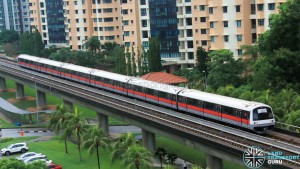























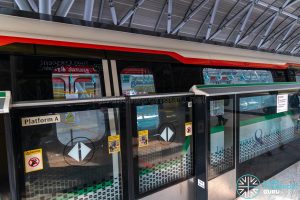













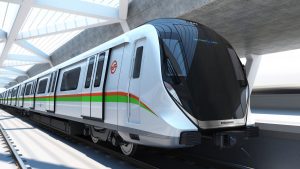








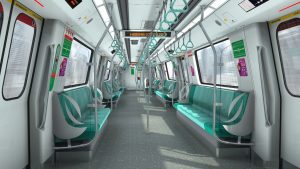



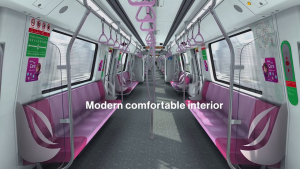

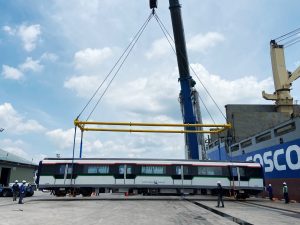




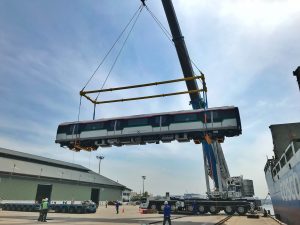

What! End 2022? Oh why not End March 2022
Cant wait to see !
Came across this article, here’s a sneak peek at the interior! Hoping for it to come any week soon 😫😬
https://www.hkitalk.net/HKiTalk2/thread-2118366-1-1.html
Alstom Metropolis CR151
Bombardier Transportation was acquired by Alstom and the deal was completed on 29 Jan 2021.